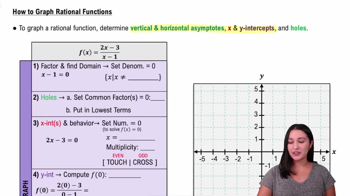Here are the essential concepts you must grasp in order to answer the question correctly.
Slant Asymptote
A slant asymptote, or oblique asymptote, occurs in rational functions when the degree of the numerator is exactly one more than the degree of the denominator. It represents the linear behavior of the function as x approaches infinity or negative infinity. To find the slant asymptote, perform polynomial long division on the rational function, where the quotient (ignoring the remainder) gives the equation of the slant asymptote.
Recommended video:
Introduction to Asymptotes
Polynomial Long Division
Polynomial long division is a method used to divide a polynomial by another polynomial of lower degree. This process is similar to numerical long division and involves dividing the leading terms, multiplying, and subtracting to simplify the expression step by step. This technique is essential for finding slant asymptotes, as it allows us to determine the linear part of the function's behavior at extreme values of x.
Recommended video:
Introduction to Polynomials
Graphing Rational Functions
Graphing rational functions involves analyzing key features such as intercepts, asymptotes, and end behavior. The seven-step strategy typically includes identifying vertical and horizontal/slant asymptotes, finding x- and y-intercepts, and determining the behavior of the function around these features. Understanding how the slant asymptote influences the graph helps in sketching the overall shape of the function, especially as x approaches infinity.
Recommended video:
How to Graph Rational Functions
 Verified step by step guidance
Verified step by step guidance Verified video answer for a similar problem:
Verified video answer for a similar problem:



 5:31m
5:31m